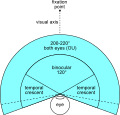Field of view
Field of View (FOV) refers to the extent of the observable world that can be seen at any given moment. In the context of vision, it is often described as the angle through which a person can see objects surrounding their point of focus. The concept of FOV is not limited to human vision; it is also applicable in photography, optics, and computing, particularly in areas such as virtual reality (VR), video games, and imaging technologies.
Definition[edit]
The field of view is typically expressed as an angle, indicating the angular extent of the observable area. In humans, the combined FOV of both eyes covers about 200 to 220 degrees horizontally, though much of this field is peripheral vision. The central part of the field of view, where we can see details most clearly, is much narrower.
Applications[edit]
Photography[edit]
In Photography, the FOV is determined by the focal length of the lens and the size of the image sensor or film. A wider FOV allows more of the scene to be captured, which is often desirable in landscape photography.
Optics[edit]
In Optics, instruments such as binoculars and telescopes have a specified FOV, which describes the diameter of the visible area observed through the instrument. A wider FOV in these contexts allows for a larger portion of the sky or landscape to be observed at once.
Virtual Reality[edit]
In Virtual Reality (VR), FOV is crucial for creating an immersive experience. A wider FOV in VR can make virtual environments feel more real and expansive, but achieving this often requires more advanced and expensive technology.
Video Games[edit]
In Video Games, the FOV affects how much of the game world the player can see on their screen. A wider FOV can provide a competitive advantage in multiplayer games by allowing players to see more of their surroundings.
Measurement[edit]
FOV can be measured in degrees, radians, or as a linear measurement at a certain distance. When measuring the FOV of cameras or lenses, two main types are often discussed: horizontal FOV and vertical FOV. The diagonal FOV can also be relevant, especially in the context of imaging sensors.
Human Vision[edit]
The human FOV varies significantly among individuals but generally encompasses a wide area that includes both central and peripheral vision. The central FOV, where we have the sharpest vision, is only about 15 degrees on either side of the focal point.
Limitations and Enhancements[edit]
Certain conditions and technologies can limit or expand the FOV. For example, wearing glasses or goggles can restrict the FOV by blocking parts of the peripheral vision. Conversely, technologies like wide-angle lenses or panoramic photography can significantly expand the FOV beyond what is naturally possible.
See Also[edit]
-
Field of view of both eyes
-
Vertical field of view
-
Angle of view
-
Abdominal CT with scan range and field of view
-
Field of view diameter in microscopy
Ad. Transform your life with W8MD's Budget GLP-1 injections from $75


W8MD offers a medical weight loss program to lose weight in Philadelphia. Our physician-supervised medical weight loss provides:
- Weight loss injections in NYC (generic and brand names):
- Zepbound / Mounjaro, Wegovy / Ozempic, Saxenda
- Most insurances accepted or discounted self-pay rates. We will obtain insurance prior authorizations if needed.
- Generic GLP1 weight loss injections from $75 for the starting dose.
- Also offer prescription weight loss medications including Phentermine, Qsymia, Diethylpropion, Contrave etc.
NYC weight loss doctor appointmentsNYC weight loss doctor appointments
Start your NYC weight loss journey today at our NYC medical weight loss and Philadelphia medical weight loss clinics.
- Call 718-946-5500 to lose weight in NYC or for medical weight loss in Philadelphia 215-676-2334.
- Tags:NYC medical weight loss, Philadelphia lose weight Zepbound NYC, Budget GLP1 weight loss injections, Wegovy Philadelphia, Wegovy NYC, Philadelphia medical weight loss, Brookly weight loss and Wegovy NYC
|
WikiMD's Wellness Encyclopedia |
| Let Food Be Thy Medicine Medicine Thy Food - Hippocrates |
Medical Disclaimer: WikiMD is not a substitute for professional medical advice. The information on WikiMD is provided as an information resource only, may be incorrect, outdated or misleading, and is not to be used or relied on for any diagnostic or treatment purposes. Please consult your health care provider before making any healthcare decisions or for guidance about a specific medical condition. WikiMD expressly disclaims responsibility, and shall have no liability, for any damages, loss, injury, or liability whatsoever suffered as a result of your reliance on the information contained in this site. By visiting this site you agree to the foregoing terms and conditions, which may from time to time be changed or supplemented by WikiMD. If you do not agree to the foregoing terms and conditions, you should not enter or use this site. See full disclaimer.
Credits:Most images are courtesy of Wikimedia commons, and templates, categories Wikipedia, licensed under CC BY SA or similar.
Translate this page: - East Asian
中文,
日本,
한국어,
South Asian
हिन्दी,
தமிழ்,
తెలుగు,
Urdu,
ಕನ್ನಡ,
Southeast Asian
Indonesian,
Vietnamese,
Thai,
မြန်မာဘာသာ,
বাংলা
European
español,
Deutsch,
français,
Greek,
português do Brasil,
polski,
română,
русский,
Nederlands,
norsk,
svenska,
suomi,
Italian
Middle Eastern & African
عربى,
Turkish,
Persian,
Hebrew,
Afrikaans,
isiZulu,
Kiswahili,
Other
Bulgarian,
Hungarian,
Czech,
Swedish,
മലയാളം,
मराठी,
ਪੰਜਾਬੀ,
ગુજરાતી,
Portuguese,
Ukrainian





